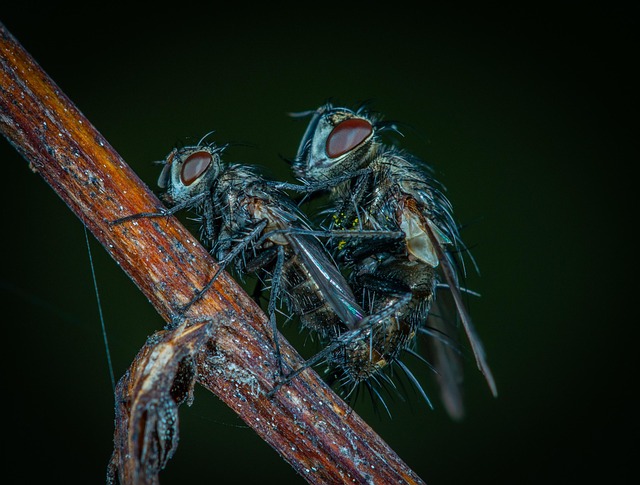Understanding fly behavior is key for property maintenance, focusing on removing attractants like food, water, and warm temperatures. Eco-friendly solutions involve cleanliness, sealing entry points, waste management, food storage, and natural repellents. Combining these with routine maintenance creates an inhospitable environment for flies, beneficial for homeowners and businesses. A strategic approach using natural methods, organic practices, and insects like ladybugs reduces environmental impact while offering long-term fly prevention. Implementing a structured monthly maintenance schedule helps identify and treat problem areas effectively. Regular monitoring and proactive management, including source control and eco-friendly solutions, are vital for successful fly control year-round.
Keeping properties fly-free requires a comprehensive approach that goes beyond superficial solutions. Effective maintenance plans involve understanding fly behavior, which often revolves around food sources and breeding grounds. This article explores an ecosystem-focused strategy, highlighting the importance of eco-friendly fly solutions in prevention. We’ll guide you through implementing these strategies, creating regular maintenance schedules, and monitoring infestations to ensure a pest-free environment.
Understanding Fly Behavior and Their Attraction to Properties
Understanding fly behavior is key to developing an effective maintenance plan for keeping properties fly-free. Flies are attracted to properties by various factors, such as food sources, water, and warm temperatures. They quickly adapt to their environment, making them persistent visitors. To deter flies, it’s essential to identify these attractions and address them proactively. This involves maintaining a clean environment, sealing entry points, and removing potential breeding grounds like standing water.
Eco-friendly fly solutions focus on non-toxic methods that minimize environmental impact while effectively managing fly populations. Implementing strategies such as regular waste management, proper food storage, and the use of natural repellents can significantly reduce fly presence. By combining these measures with routine property maintenance, homeowners and businesses can create an inhospitable environment for flies, ensuring a more comfortable living or working space.
Implementing Eco-Friendly Strategies for Prevention
Implementing eco-friendly fly solutions is a strategic approach that not only minimizes the impact on the environment but also offers long-term prevention for property owners. By opting for natural repellents and organic practices, properties can effectively reduce fly populations without resorting to harsh chemicals. One such method involves introducing beneficial insects like ladybugs or lacewings, which feed on flies, into the area. This biological control approach is a safe and sustainable way to manage fly problems.
Additionally, proper waste management and regular cleaning play a significant role in eco-friendly fly prevention. Ensuring that trash bins are tightly sealed and promptly emptying them can significantly reduce fly attractions. Maintaining clean outdoor spaces, removing standing water, and properly disposing of organic waste all work together to create an environment less hospitable to flies. These strategies not only promote a healthier living space but also contribute to the overall ecological balance.
Creating a Regular Maintenance Schedule
Creating a regular maintenance schedule is a key strategy in implementing effective ongoing maintenance plans to keep properties fly-free. It involves setting aside dedicated time each month to inspect and treat areas prone to fly infestations, such as garbage bins, food storage spaces, and drainage systems. Using eco-friendly fly solutions can be integrated seamlessly into this routine; natural repellents like essential oils or fly traps baited with non-toxic attractants are ideal for regular deployment.
By scheduling these activities consistently, property managers or homeowners can prevent flies from breeding and thriving. Regular maintenance also ensures that any signs of infestation are caught early, making it easier and more cost-effective to address the issue. This proactive approach not only keeps properties clean and hygienic but also contributes to a healthier living or working environment by minimizing exposure to potential allergens and disease vectors associated with flies.
Monitoring and Addressing Infestations Effectively
Regular monitoring and effective infestation addressing are key components of any successful fly control strategy. Property managers should implement a year-round plan that includes routine inspections to identify potential breeding grounds and early signs of an incoming fly problem. This proactive approach allows for swift action using eco-friendly fly solutions, minimizing the need for harsh chemicals. By staying ahead of infestations, managers can maintain a clean and healthy living environment for residents while preserving the property’s value.
When addressing fly issues, it’s crucial to pinpoint the source—whether it’s garbage, pet waste, or standing water—and eliminate it immediately. Eco-friendly methods like improving sanitation practices, installing fly traps, and using natural repellents can be highly effective. Regular cleaning schedules, proper waste management, and routine maintenance checks are essential for preventing future infestations.
Maintaining a fly-free environment is achievable through a comprehensive approach. By understanding fly behavior, adopting eco-friendly strategies, and implementing regular maintenance, property managers can significantly reduce infestations. A well-planned schedule, coupled with effective monitoring, ensures these pesky intruders are kept at bay. Embracing eco-friendly fly solutions not only protects properties but also contributes to a healthier environment.
